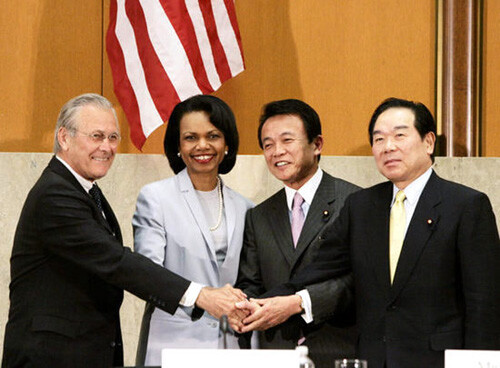hankyoreh
Links to other country sites 다른 나라 사이트 링크
U.S. Japan Envision 'Interoperability' in Troop Realignment Plan

Wrapping up more than three years of extended negotiations, Tokyo and Washington signed on Monday a set of agreements on a U.S. military realignment package.
In a nutshell, the finalized plan aims to take the U.S.-Japan alliance to a new level by strengthening Japan-U.S. military cooperation and promoting the "interoperability" of the U.S. military in Japan and Japan’s Self-Defense Forces.
Foreign Minister Taro Aso, Defense Agency Director General Fukushiro Nukaga, U.S. Secretary of State Condoleezza Rice and Defense Secretary Donald Rumsfeld released a joint statement after their meeting in Washington DC, saying that the implementation of these realignment initiatives will lead to a new phase in alliance cooperation.
The finalized agreements envision a greater role for the U.S. headquarters command in Japan in connection with growing threats of terrorist attacks and China’s influence in the region. The U.S. is planning to relocate the First Army Corps Headquarters from the U.S. mainland to Camp Zama of Kanagawa Prefecture by 2008 and establish a UEX (unit of employment) there. The U.S. forces plan to build 20 UEXs around the world.
Zama is expected to play a key role in contingencies in areas surrounding Japan such as the Korean Peninsula and the Taiwan Strait. In a situation where the U.S. is set to reduce its military presence in South Korea, the new U.S. Army command to be set up at Camp Zama would assume charge in an emergency on the Korean Peninsula.
The agreements put the finishing touches on such thorny issues as the transfer of some 8,000 U.S. Marines from Okinawa to Guam, which will eventually facilitate the deployment of U.S. forces to Southeast Asia, a region the U.S. sees as a hotbed of terrorism.
The two countries’ respective headquarters in Japan will be brought together to strengthen interoperability between the Japanese and U.S. forces in hopes of maximizing the benefits at the lowest cost possible. Including the latest decision, there have been three major occasions of U.S. military forces in Japan undergoing structural changes since the early years of the Cold War, and the changes have been made in a way to deepen their bilateral alliance, experts note.
Meanwhile, the headquarters of a Ground Self-Defense Force Central Readiness Force Command will also be transferred to Camp Zama by 2012, a move that will enhance the interoperability of the two countries' forces and pave the way for the operational integration of the flagship forces. In this context, Japan's Air Defense Command will be moved to the headquarters of the U.S. 5th Air Force at Yokota Air Base in Tokyo by 2010 while acting as the headquarters for MD (missile defenses) functions.
However, the military realignment plan is expected to run into a number of obstacles. The proposed expansion in Japan’s military role might pose a threat to regional stability in East Asia, thus giving rise to serious oppositions from its neighbors and heated domestic debate on the revision of its constitution, which renounces on military capability.
Moreover, some communities like Kanagawa Prefecture and Iwakuni City, which are designated to host the U.S. facilities, still oppose the plans, while the Japanese government is expected to fight an uphill battle to convince its taxpayers into shouldering the necessary costs for the shake-up of the U.S. forces.
When a high-ranking U.S. official estimated Japan’s share at $26 billion recently, members of the Japanese public said the figure was "outrageous." arguing that the U.S. treats Japan like a "cash dispenser."
Park Jung-eon, Tokyo
parkje@hani.co.kr
Editorial・opinion
![[Column] Season 2 of special prosecutor probe may be coming to Korea soon [Column] Season 2 of special prosecutor probe may be coming to Korea soon](https://flexible.img.hani.co.kr/flexible/normal/500/300/imgdb/original/2024/0426/3317141030699447.jpg) [Column] Season 2 of special prosecutor probe may be coming to Korea soon
[Column] Season 2 of special prosecutor probe may be coming to Korea soon![[Column] Park Geun-hye déjà vu in Yoon Suk-yeol [Column] Park Geun-hye déjà vu in Yoon Suk-yeol](https://flexible.img.hani.co.kr/flexible/normal/500/300/imgdb/original/2024/0424/651713945113788.jpg) [Column] Park Geun-hye déjà vu in Yoon Suk-yeol
[Column] Park Geun-hye déjà vu in Yoon Suk-yeol- [Editorial] New weight of N. Korea’s nuclear threats makes dialogue all the more urgent
- [Guest essay] The real reason Korea’s new right wants to dub Rhee a founding father
- [Column] ‘Choson’: Is it time we start referring to N. Korea in its own terms?
- [Editorial] Japan’s rewriting of history with Korea has gone too far
- [Column] The president’s questionable capacity for dialogue
- [Column] Are chaebol firms just pizza pies for families to divvy up as they please?
- [Column] Has Korea, too, crossed the Rubicon on China?
- [Correspondent’s column] In Japan’s alliance with US, echoes of its past alliances with UK
Most viewed articles
- 1Samsung subcontractor worker commits suicide from work stress
- 2Division commander ordered troops to enter raging flood waters before Marine died, survivor says
- 3No good, very bad game for Korea puts it out of Olympics for first time since 1988
- 4‘We must say no’: Seoul defense chief on Korean, USFK involvement in hypothetical Taiwan crisis
- 5[Column] Season 2 of special prosecutor probe may be coming to Korea soon
- 6Is N. Korea threatening to test nukes in response to possible new US-led sanctions body?
- 7Korea’s 1.3% growth in Q1 signals ‘textbook’ return to growth, says government
- 8US overtakes China as Korea’s top export market, prompting trade sanction jitters
- 9[Column] Has Korea, too, crossed the Rubicon on China?
- 10[Column] ‘Choson’: Is it time we start referring to N. Korea in its own terms?